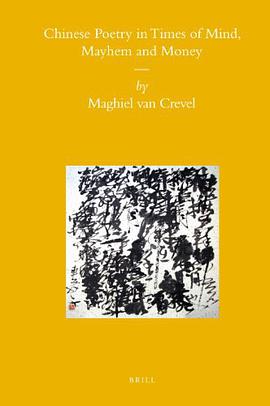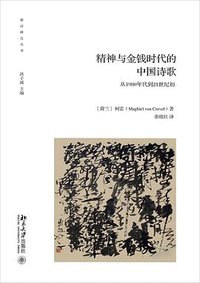Chinese Poetry in Times of Mind, Mayhem and Money
豆瓣
Maghiel van Crevel
简介
Chinese Poetry in Times of Mind, Mayhem and Money is a groundbreaking contribution to scholarship, well-suited to classroom use in that it combines rigorous analysis with a lively style. Covering the period from the 1980s to the present, it is organized around the notions of text, context and metatext, meaning poetry, its socio-political and cultural surroundings, and critical discourse in the broadest sense. Authors and issues studied include Han Dong, Haizi, Xi Chuan, Yu Jian, Sun Wenbo, Yang Lian, Wang Jiaxin, Bei Dao, Yin Lichuan, Shen Haobo and Yan Jun, and everything from the subtleties of poetic rhythm to exile-bashing in domestic media. This book has room for all that poetry is: cultural heritage, symbolic capital, intellectual endeavor, social commentary, emotional expression, music and the materiality of language – art, in a word.
contents
CONTENTS
Preface . . . . . . . . . . . . . . . . . . . . . . . . . . . . . . . . . . . . . . . . . . . ix
Acknowledgments . . . . . . . . . . . . . . . . . . . . . . . . . . . . . . . . . . xi
Conventions . . . . . . . . . . . . . . . . . . . . . . . . . . . . . . . . . . . . . . xiii
List of Illustrations . . . . . . . . . . . . . . . . . . . . . . . . . . . . . . . . . xvii
Chapter One
Avant-Garde Poetry from China: Text, Context and Metatext 1
1. What Went Before . . . . . . . . . . . . . . . . . . . . . . . . . . . . . 1
2. The Unofficial Poetry Scene and the Avant-Garde . . . . 5
3. Context: Times of Mind, Mayhem and Money . . . . . . . 13
4. Text: From Elevated to Earthly and from What to How 23
5. Metatext: Images of Poetry and Poethood . . . . . . . . . . . 30
6. The Case Studies, and What This Book Wants to Do 50
Chapter Two
True Disbelief: Han Dong . . . . . . . . . . . . . . . . . . . . . . . . . . . 63
1. The Rejection of Obscure Poetry . . . . . . . . . . . . . . . . . 65
2. An Original Poetics . . . . . . . . . . . . . . . . . . . . . . . . . . . . 76
Chapter Three
Thanatography and the Poetic Voice: Haizi . . . . . . . . . . . . . 91
1. Thanatography . . . . . . . . . . . . . . . . . . . . . . . . . . . . . . . . 95
2. The Poetic Voice . . . . . . . . . . . . . . . . . . . . . . . . . . . . . . 123
Chapter Four
Exile: Yang Lian, Wang Jiaxin and Bei Dao . . . . . . . . . . . . . 137
1. Poets in Exile . . . . . . . . . . . . . . . . . . . . . . . . . . . . . . . . . 146
2. Exile in Poetry . . . . . . . . . . . . . . . . . . . . . . . . . . . . . . . . 159
Chapter Five
Mind over Matter, Matter over Mind: Xi Chuan . . . . . . . . 187
1. Spirituality versus Materialism and the Barbarians . . . 189
2. A Different Voice: Poetry Rising, Poets Falling . . . . . . 194
3. Words Capturing Images, Images Capturing Words . . . 215
Chapter Six
Fringe Poetry, But Not Prose: Xi Chuan and Yu Jian . . . . . 223
1. A Wonderful Inadequacy of Definitions . . . . . . . . . . . . 225
2. «Salute» and «File 0»: Poetry or Prose? . . . . . . . . . . . . 229
3. Fringe Poetry . . . . . . . . . . . . . . . . . . . . . . . . . . . . . . . . . 244
Chapter Seven
Objectification and the Long-Short Line: Yu Jian . . . . . . . . 247
1. Objectification and Subjectification . . . . . . . . . . . . . . . . 252
2. Long Lines and Blanks . . . . . . . . . . . . . . . . . . . . . . . . . . 274
Chapter Eight
Narrative Rhythm, Sound and Sense: Sun Wenbo . . . . . . . . 281
1. Content Bias . . . . . . . . . . . . . . . . . . . . . . . . . . . . . . . . . . 284
2. «The Program»: Content and Plot . . . . . . . . . . . . . . . . 288
3. «The Program»: Form . . . . . . . . . . . . . . . . . . . . . . . . . . 294
4. Narrativity and Its Context . . . . . . . . . . . . . . . . . . . . . . 301
Chapter Nine
The Lower Body: Yin Lichuan and Shen Haobo . . . . . . . . . 305
1. Lower Body Poetry . . . . . . . . . . . . . . . . . . . . . . . . . . . . 307
2. A Poetic Lineage . . . . . . . . . . . . . . . . . . . . . . . . . . . . . . 338
Chapter Ten
Not at Face Value: Xi Chuan’s Explicit Poetics . . . . . . . . . . 345
1. Explanations, Issues and Alchemy . . . . . . . . . . . . . . . . . 347
2. A Bigger Picture . . . . . . . . . . . . . . . . . . . . . . . . . . . . . . . 360
Chapter Eleven
Desecrations? Han Dong’s and Yu Jian’s Explicit Poetics . . . 365
1. Poethood According to Han Dong and Yu Jian . . . . . . 366
2. Metatextual Styles. . . . . . . . . . . . . . . . . . . . . . . . . . . . . . 392
Chapter Twelve
What Was All the Fuss About? The Popular-Intellectual Polemic 399
1. What Were the Issues? . . . . . . . . . . . . . . . . . . . . . . . . . . 400
2. What Was at Stake? . . . . . . . . . . . . . . . . . . . . . . . . . . . . 441
Appendix: A Chronological Bibliography . . . . . . . . . . . . . . 451
Chapter Thirteen
More Than Writing, As We Speak: Yan Jun . . . . . . . . . . . . 459
1. Three-Dimensional Performance . . . . . . . . . . . . . . . . . 461
2. Writing, Event Culture and Poetry Opening Up . . . . . 471
Works Cited . . . . . . . . . . . . . . . . . . . . . . . . . . . . . . . . . . . . . . 475
Index and Glossary . . . . . . . . . . . . . . . . . . . . . . . . . . . . . . . . . 505
